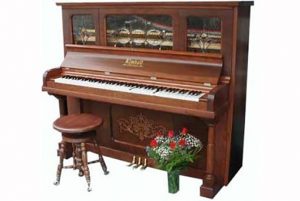To prepare a grand piano for moving, first, lift off its music rack and remove its lyre. Then, its legs all need to be removed and it needs to be padded and securely strapped in its side to a piano
The keyboard (referred to as the piano’s action) should only be removed by a qualified piano technician. In most cases, when moving a grand piano, the keyboard action need not be removed. So ask your piano tuner what they would recommend for your particular piano.
How to Remove a Grand Piano’s Lyre
Below is a picture depicting the removal of a grand piano’s lyre. This task is fairly easy because it involves just unscrewing and removing the lyre-pedal assembly from the underside of the piano.

Only the lyre-pedal assembly with its two wooden push rods needs to actually be removed from the piano (the picture below shows a rectangular, light spot on the wood with the 3 screw holes where the piano’s lyre-pedal assembly has been removed).

The other pieces of the mechanism can remain attached to the underside of the piano (as is shown above) because they don’t bulge out much. The idea here is to make the grand piano flat underneath so that when it’s tipped up onto its side upon the piano
How to Remove a Grand Piano’s Legs
The first step after removing the music rack and the lyre is to remove the piano’s left side front leg. This is done by elevating the piano from its playing position up about 6″. Have 1 person lift the end of the piano and have a 2-nd person stand the piano dolly under the left side of the keyboard about a foot and a half in, as shown below.

Once in place, the dolly will hold the left end of the piano up a few inches so that the leg can be removed (without people having to physically kill themselves holding it up while that’s being done). Being lifted a bit on one side like this does not put undue strain on the grand piano’s other two legs.
It’s then necessary to have someone stand there and straddle the dolly in order to hold it steady until another person finishes removing that side’s leg.

Most piano legs have long screws securing each leg to a hidden coupler between the leg and the underside of the piano. So the screws must be removed to uncouple it. However, some grands have legs that merely have to be screwed off because they have a center machined bolt assembly securing them. Some older grand pianos have a fat, wooden screw dowel (that can easily break with age) connecting the leg to the piano.
The following picture sequence is of a piano leg being disassembled by removing its long screws which are holding it onto the piano’s base and securing its coupler.

When the leg’s screws have been fully removed, it can then be hand-shifted and pulled down out of its coupler as shown below. Sometimes a rubber mallet is needed to pound a stuck leg

Each leg’s underside and the piano’s corresponding underside leg position should be marked in some way to match them back up later since each leg may have slightly differing coupler hardware. Notice in the picture below the etched 1’s in the wood to indicate 1st leg. II would indicate the 2-

Once one leg is removed, the piano is lifted off of the dolly by two people and gently lowered (on that leg’s side) onto the padded piano skid board on the floor underneath it as shown in the picture sequence below.

Notice how these highly-experienced movers crouch down, keeping their backs straight and healthy as they set this heavy load onto the edge of the piano board.
From this position (shown in the picture below at a different angle), the piano can now be lifted, tipping it onto its flat side right up onto the piano board.

Below, the movers lift the piano all the way up onto its side onto the top of the piano board so that the other two legs can be removed.

These skilled guys make a hard job look easy, don’t they?

There is one other mover who’s not shown, who’s holding one end of the piano board in place so that it doesn’t slip while the movers lift the piano.

Voila! It’s now safely butted up against the piano board’s lip and centered on it. It’s always kept in this butted position so that it won’t slip forward when it is tipped or carried on an angle. Now its ready for the removal of the other two legs.

The sequence above has been shown without padding or strapping for simplicity’s sake.

As the piano is shown above merely sitting balanced upon the dolly, it could be moved internally in a residence if it would be traversing a
When the piano is padded (it can additionally be covered with a grand piano cover as shown in the picture below) and strapped tightly to the piano board, you would tip it up, always leaning it towards the piano board’s front lip so that it won’t slip and so that a dolly can be centered underneath it.
You can also fully pad and then strap the piano board to your piano while its still standing up on its feet (shown below).

Then continue from here to Dollying and Ramping a Grand Piano
Disassembling a grand piano is not easy by any means. If you’re unsure how to prepare your grand piano for a safe move, then get free quotes from professional piano movers to see how much they will charge you for that tough job.


